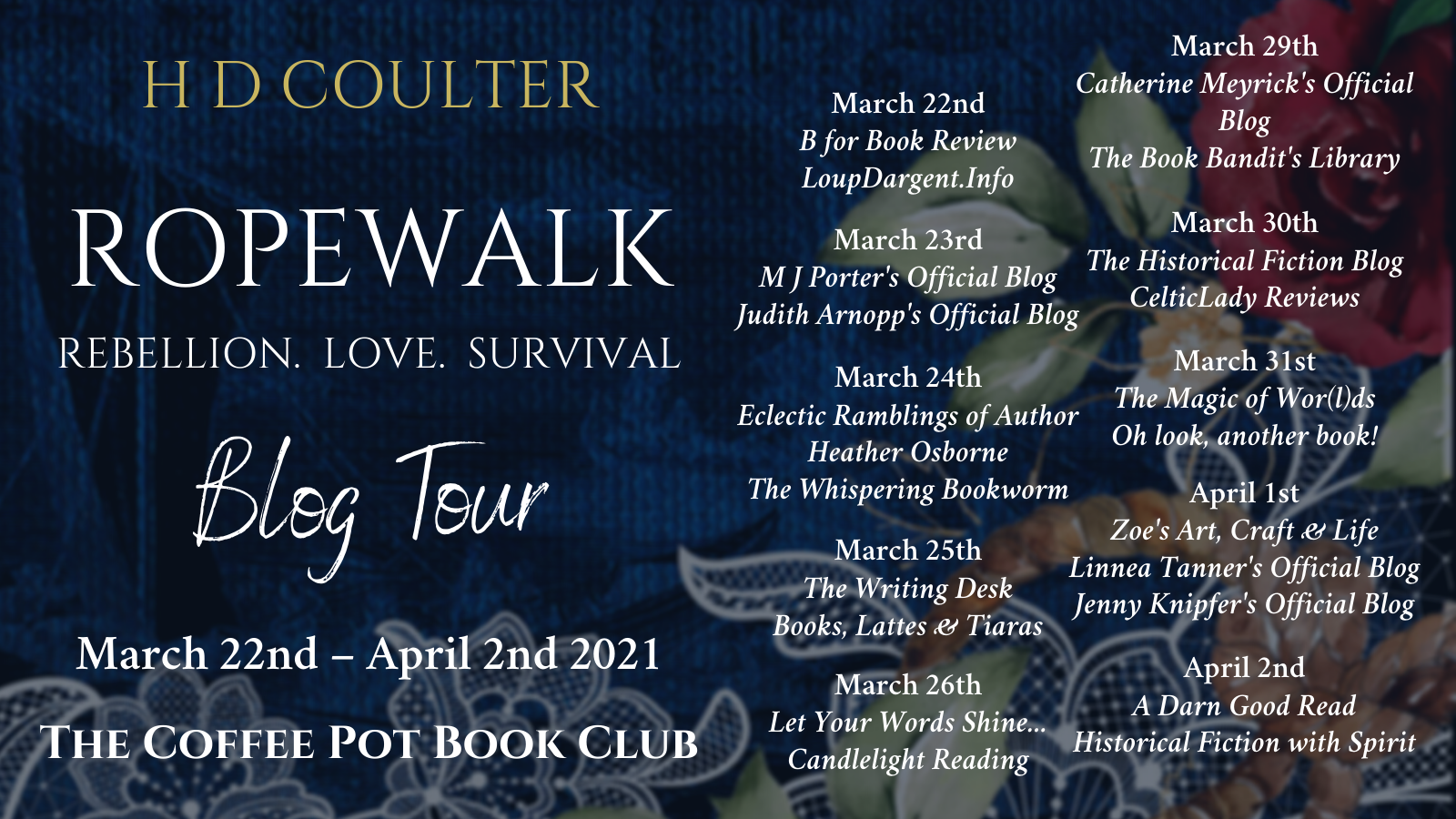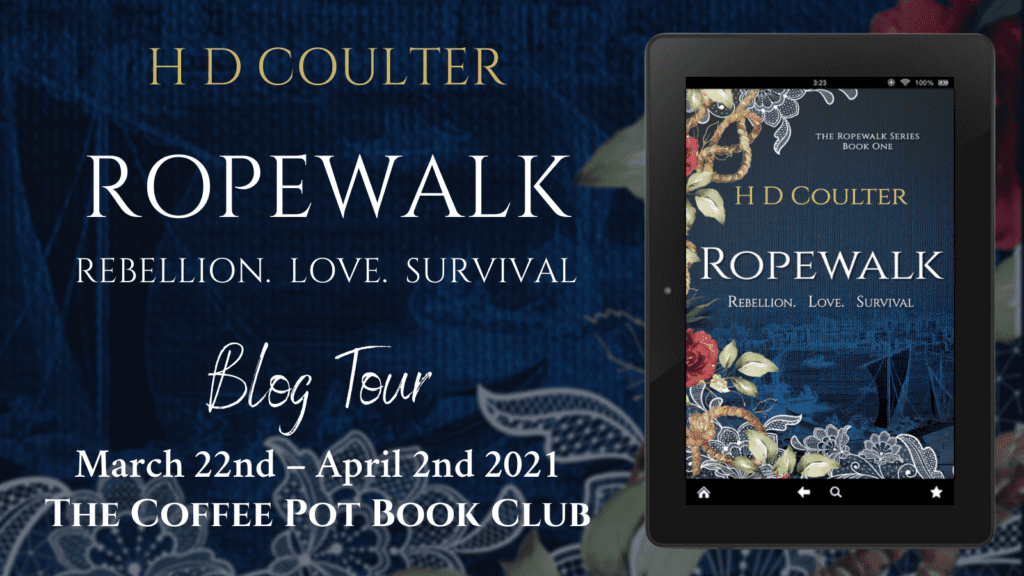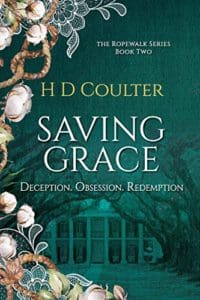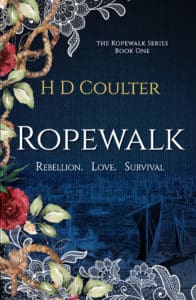
31 Mar H D Coulter Book Title: Ropewalk: Rebellion. Love. Survival The Coffee Pot Book Club Blog Tour #HistoricalFiction #Ropewalk #BlogTour #CoffeePotBookClub @coulter_hd @maryanneyarde
FEATURED AUTHOR: H D COULTER
It is my pleasure to feature H D Coulter as part of The Coffee Pot Book Club Blog Tour being held from March 22 – April 2, 2021. H D Coulter is the author of the historical fiction novel, Ropewalk: Rebellion. Love. Survival [The Ropewalk Series (Book 1)], which was independently released by the author on 23 November 2020 (243 pages).
Below are highlights of Ropewalk: Rebellion. Love. Survival, H D Coulter’s author biography, and her inspiration behind writing the book.

HIGHLIGHTS: ROPEWALK: REBELLION. LOVE. SURVIVAL
ROPEWALK: REBELLION. LOVE. SURVIVAL
The Ropewalk Series (Book 1)
by H D Coulter
The North of England, 1831.
The working class are gathering. Rebellion is stirring, and the people are divided.
Beatrice Lightfoot, a young woman fighting her own personal rebellion, is looking for an opportunity to change her luck. When she gains the attention of the enigmatic Captain Hanley, he offers her a tantalising deal to attend the May Day dance. She accepts, unaware of the true price of her own free will.
Her subsequent entanglement with Joshua Mason, the son of a local merchant, draws all three into a destructive and dangerous relationship, which threatens to drag Beatrice, and all she knows into darkness.
Now, Beatrice must choose between rebellion, love and survival before all is lost, and the Northern uprising changes her world forever.
The e-book of Ropewalk: Rebellion. Love. Survival has been reduced to £0.99 during this promotion. Signed copies of the paperbacks are available at Hayley’s website – https://hdcoulter.com/
Buy Links:
Amazon UK ∗ Amazon US ∗ Universal Link to Other Bookshops
COMING SOON!
 SAVING GRACE: DECEPTION. OBSESSION. REDEMPTION
SAVING GRACE: DECEPTION. OBSESSION. REDEMPTION
The Ropewalk Series (Book 2)
by H D Coulter
Beacon Hill, Boston. 1832.
“You are innocent. You are loved. You are mine.”
After surviving the brutal attack and barely escaping death at Lancaster Castle, Beatrice Mason attempts to build a new life with her husband Joshua across the Atlantic in Beacon Hill. But, as Beatrice struggles to cope with the pregnancy and vivid nightmares, she questions whether she is worthy of redemption.
Determined to put the past behind her after the birth of her daughter Grace, Bea embraces her newfound roles of motherhood and being a wife. Nevertheless, when she meets Sarah Bateman, their friendship draws Bea towards the underground abolitionist movement, despite the dangerous secrets it poses. Whilst concealed in the shadows, Captain Victor Hanley returns, obsessed with revenge and the desire to lay claim to what is his, exposes deceptions and doubts as he threatens their newly established happiness.
Now, Beatrice must find the strength to fight once more and save Grace, even if it costs her life.
Preorder Links:
Amazon UK ∗ Amazon US ∗ Universal Link to Other Bookshops:
AUTHOR BIO: H D Coulter
Hayley was born and raised in the lake district and across Cumbria. From a young age, Hayley loved learning about history, visiting castles and discovering local stories from the past. Hayley and her partner lived in Ulverston for three years and spent her weekends walking along the Ropewalk and down by the old harbour. She became inspired by the spirit of the area and stories that had taken place along the historic streets.
As a teacher, Hayley had loved the art of storytelling by studying drama and theatre. The power of the written word, how it can transport the reader to another world or even another time in history. But it wasn’t until living in Ulverston did she discover a story worth telling. From that point, the characters became alive and she fell in love with the story.
Social Media Links:
Website
What was the inspiration behind Ropewalk?
I’d first like to thank Linnea Tanner for inviting me to guest post during the blog tour for Ropewalk: Rebellion. Love. Survival.
I am constantly inspired by history, discovering parts of the past I didn’t know about and fuelling the fire to research.
‘You don’t know where you are going until you know where you have been.’
I find it fascinating to look back and research into certain time frames and how someone can discover additional evidence, and it changes the whole narrative of what we thought about that time. But it also reflects how important story telling is, from a painting on the cave walls, to Mr Peeps diaries in 1500s, to plays and novels. A modern reflection of life for the author, but to us it varies from an idealistic view of the world to a realistic observation.
My first love would be from novelists around 1800s, who give a snippet of life during that time. A handful of novels have had an affected on me; ‘North and South’, ‘Persuasion’, ‘Jane Eyre’, ‘Far from the madding crowd’, and ‘Jamaica Inn.’ I find myself consumed by the world the novelist created, believing I know the characters as if I have had umpteen conversations with them. Or I’ve been inspired by the historical novelist in today’s publishing market in the way of Philippa Gregory, Kate Mosse, and Diane Setterfield to name a few.
However, Ropewalk didn’t manifest in my mind’s eyes until one night I had a dream of a woman called Beatrice and a man called Joshua. When I woke the dream was still there and I could replay scenes as if I had watched a film the night before. Over the next couple of days and weeks, the more I walked around Ulverston, the people became real. I researched the Ropewalk, feeling drawn to it at the weekend, then the canal followed by the time frame and the social injustice. I researched it to the point the characters became flesh and blood. When I walked down Market street, it wasn’t 2014 (the year I started the novel); it was 1831.
I plotted out the story as I would do breaking down a play or beats in a film. I would imagine the scene and the characters in my head, describing the tiny details as I zoomed in and out. For me as a writer, the most important aspect to a novel is that it feels natural in events, dialogue, action and reaction. Beatrice’s background: she is a young woman who lives with her parents in a small hamlet with her five younger brothers and sisters. They run a growing business, but she helps to bring in extra money by creating lace to sell whilst attending a small vegetable patch, a cow, catching rabbits and other animals in snares. It has taught her to live off the land when money is tight, but despite that, she has a fire inside of her to helping others, dreams of adventures and escaping. That is her baseline, her norm, so what happens after that point needs to be a natural reaction, especially if you add several dynamics which take place to turn her world upside down. That is something which drew me to the novels listed above. The situations, the place, and characters in the novels seem realistic. How Jane Eyre sees the same kindred spirit in herself as in Mr Rochester and how he longs for her innocence compared to his wife’s insanity. Or North and South, the comparison between the gentry and the poor, the industrial town and the countryside, the fight the workers display against the leisure of the rich and so on.
The research led me to the Reformers and the power they were gaining in the north. How over the course of 50 years Ulverston became an industrial port compared to its quiet past. It was a contender for trade bringing factories, mills, gentry and the poor. Then after 50 years the railroad arrived, linking in Barrow port to the fells and across the sands to Lancaster, avoiding Ulverston and the need for the canal.
Each of the principal characters represents an element that was happening in the country. Bob Lightfoot, the ropemaker, which was a cottage industry, fought for his rights, like so many of his childhood friends working the mills, shipyards, canal. Beatrice Lightfoot, having her father’s spirit, dreamt of change but is oppressed by the conformity of the time and societal class division. Joshua Mason, the son of a local merchant who became gentry and part of the family who built the canal, sees the plight of the workers thanks to Beatrice. Captain Hanley is a complex character, a sailor like so many men passing through Ulverston and effected from past trading routes including the slave trade, becomes obsessed with Beatrice. Whilst Ulverston itself, the nucleus for change but unable to cope with the demand. These threads come together during a volatile period and form the complex tapestry of Ropewalk.
 Instagram: @coffeepotbookclub
Instagram: @coffeepotbookclub



Mary Anne Yarde
Posted at 01:43h, 01 AprilThank you so much for hosting today’s tour stop.
Linnea Tanner
Posted at 15:59h, 01 AprilHi Mary Anne–It’s a pleasure to host H D Coulter and her book, “Ropewalk: Rebellion. Love. Survival,” as part of the Coffee Pot Book Blog Tour.
Jan Sikes
Posted at 13:03h, 01 AprilThank you for sharing, Linnea. This is a new author to me.
Linnea Tanner
Posted at 16:02h, 01 AprilHi Jan–Thank you for visiting and commenting. It’s always a pleasure to highlight different authors. Hope you have a wonderful week!
Maura Beth Brennan
Posted at 05:35h, 02 AprilHad not known of this author. Thank you for introducing her to us, Linnea. Good luck with your books and tour, Hayley!
Linnea Tanner
Posted at 11:19h, 08 AprilHi Maura Beth–Thank you for visiting and commenting on the blog tour for H.D. Coulter and her book. It is always a pleasure to introduce authors and learn more about their work. Hope you have a wonderful week!
Luciana
Posted at 02:04h, 09 AprilInteresting story, though not too familiar with this period of history. Thank you for sharing!
Hope you are keeping well and staying safe, Linnea.